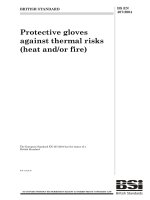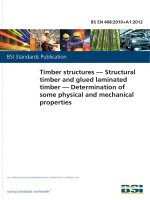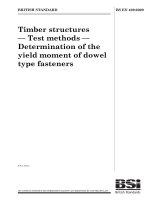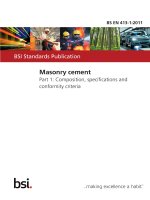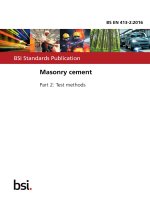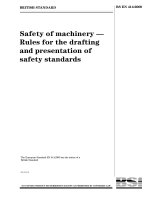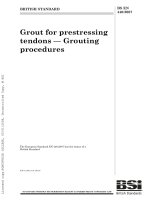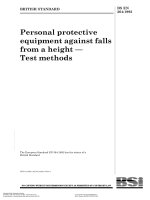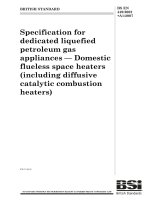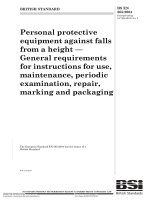Bsi bs en 13807 2017
Bạn đang xem bản rút gọn của tài liệu. Xem và tải ngay bản đầy đủ của tài liệu tại đây (1.83 MB, 28 trang )
BS EN 13807:2017
BSI Standards Publication
Transportable gas cylinders
— Battery vehicles and
multiple-element gas
containers (MEGCs) — Design,
manufacture, identification and
testing
BS EN 13807:2017
BRITISH STANDARD
National foreword
This British Standard is the UK implementation of EN 13807:2017.
It supersedes BS EN 13807:2003 which is withdrawn.
The UK participation in its preparation was entrusted to Technical
Committee PVE/3/7, Gas containers - Gas cylinder (receptacle)
operations.
A list of organizations represented on this committee can be
obtained on request to its secretary.
This publication does not purport to include all the necessary
provisions of a contract. Users are responsible for its correct
application.
© The British Standards Institution 2017.
Published by BSI Standards Limited 2017
ISBN 978 0 580 83885 9
ICS 23.020.35
Compliance with a British Standard cannot confer immunity from
legal obligations.
This British Standard was published under the authority of the
Standards Policy and Strategy Committee on 28 February 2017.
Amendments/corrigenda issued since publication
Date
Text affected
BS EN 13807:2017
EN 13807
EUROPEAN STANDARD
NORME EUROPÉENNE
EUROPÄISCHE NORM
February 2017
ICS 23.020.35
Supersedes EN 13807:2003
English Version
Transportable gas cylinders - Battery vehicles and
multiple-element gas containers (MEGCs) - Design,
manufacture, identification and testing
Bouteilles à gaz transportables - Véhicules-batteries et
conteneurs à gaz à éléments multiples (CGEM) Conception, fabrication, identification et essai
Ortsbewegliche Gasflaschen - Batterie-Fahrzeuge und
Gascontainer mit mehreren Elementen (MEGCs) Auslegung, Herstellung, Kennzeichnung und Prüfung
This European Standard was approved by CEN on 21 December 2016.
CEN members are bound to comply with the CEN/CENELEC Internal Regulations which stipulate the conditions for giving this
European Standard the status of a national standard without any alteration. Up-to-date lists and bibliographical references
concerning such national standards may be obtained on application to the CEN-CENELEC Management Centre or to any CEN
member.
This European Standard exists in three official versions (English, French, German). A version in any other language made by
translation under the responsibility of a CEN member into its own language and notified to the CEN-CENELEC Management
Centre has the same status as the official versions.
CEN members are the national standards bodies of Austria, Belgium, Bulgaria, Croatia, Cyprus, Czech Republic, Denmark, Estonia,
Finland, Former Yugoslav Republic of Macedonia, France, Germany, Greece, Hungary, Iceland, Ireland, Italy, Latvia, Lithuania,
Luxembourg, Malta, Netherlands, Norway, Poland, Portugal, Romania, Serbia, Slovakia, Slovenia, Spain, Sweden, Switzerland,
Turkey and United Kingdom.
EUROPEAN COMMITTEE FOR STANDARDIZATION
COMITÉ EUROPÉEN DE NORMALISATION
EUROPÄISCHES KOMITEE FÜR NORMUNG
CEN-CENELEC Management Centre: Avenue Marnix 17, B-1000 Brussels
© 2017 CEN
All rights of exploitation in any form and by any means reserved
worldwide for CEN national Members.
Ref. No. EN 13807:2017 E
BS EN 13807:2017
EN 13807:2017 (E)
Contents
Page
European foreword....................................................................................................................................................... 4
Introduction .................................................................................................................................................................... 5
1
Scope .................................................................................................................................................................... 6
2
Normative references .................................................................................................................................... 6
3
Terms and definitions ................................................................................................................................... 7
4
4.1
4.2
4.2.1
4.2.2
4.2.3
4.2.4
4.3
4.4
4.5
4.6
4.7
Design .................................................................................................................................................................. 9
General ................................................................................................................................................................ 9
Mounting ......................................................................................................................................................... 10
Stability (for battery vehicles only)....................................................................................................... 10
Attachment of pressure receptacles to a chassis .............................................................................. 10
Pressure receptacle supports .................................................................................................................. 10
Impact protection......................................................................................................................................... 11
Pressure receptacles ................................................................................................................................... 11
Valves and fittings ........................................................................................................................................ 11
Manifold ........................................................................................................................................................... 12
Main valve(s)/connection(s) ................................................................................................................... 12
Total assembly .............................................................................................................................................. 13
5
Manufacturing ............................................................................................................................................... 13
6
6.1
6.2
6.3
Identification ................................................................................................................................................. 13
General ............................................................................................................................................................. 13
Product and hazard identification ......................................................................................................... 13
Filling identification .................................................................................................................................... 14
7
7.1
7.2
7.2.1
7.2.2
7.2.3
7.2.4
7.3
7.3.1
7.3.2
7.3.3
7.3.4
Type approval, inspection and testing ................................................................................................. 14
General ............................................................................................................................................................. 14
Type approval of battery vehicle or MEGC .......................................................................................... 14
Design check of the battery vehicle or MEGC ..................................................................................... 14
Testing of the manifold and battery vehicle or MEGC ..................................................................... 14
Flame resistance of cover sheets ............................................................................................................ 14
Conductivity of cover sheets .................................................................................................................... 14
Initial inspection of fully assembled battery vehicle or MEGC .................................................... 15
General ............................................................................................................................................................. 15
Manifold ........................................................................................................................................................... 15
Fully assembled battery vehicle or MEGC ........................................................................................... 15
Identification ................................................................................................................................................. 15
8
Documentation.............................................................................................................................................. 15
Annex A (normative) Specific requirements for dissolved acetylene battery vehicles ................... 17
A.1
General ............................................................................................................................................................. 17
A.2
Design ............................................................................................................................................................... 17
A.2.1 Material............................................................................................................................................................ 17
A.2.2 Layout ............................................................................................................................................................... 17
A.2.3 Acetylene cylinders and acetylene bundles of cylinders ............................................................... 17
2
BS EN 13807:2017
EN 13807:2017 (E)
A.2.4 Cylinder valves .............................................................................................................................................. 17
A.2.5 Manifold ........................................................................................................................................................... 17
A.2.5.1 General ............................................................................................................................................................. 17
A.2.5.2 Wall thickness of the pipe system........................................................................................................... 17
A.2.5.3 System with wall thickness to withstand detonation and reflection occurring at any
point .................................................................................................................................................................. 18
A.2.5.4 System to withstand undisturbed detonation with reinforcements at reflection
points ................................................................................................................................................................ 18
A.2.5.5 Design by means of acetylene decomposition testing ..................................................................... 19
A.2.5.6 Flexible hoses ................................................................................................................................................. 19
A.2.6 Valves (excluding the cylinder valves and the main valve)........................................................... 19
A.2.7 Safety devices ................................................................................................................................................. 19
A.2.7.1 Design for configurations .......................................................................................................................... 19
A.2.7.2 Type approval requirement for acetylene decomposition blocker ........................................... 20
A.2.8 Ventilation....................................................................................................................................................... 20
A.3
Identification .................................................................................................................................................. 20
A.3.1 General ............................................................................................................................................................. 20
A.3.2 Colour coding ................................................................................................................................................. 20
A.3.3 Filling identification .................................................................................................................................... 20
A.4
Testing .............................................................................................................................................................. 21
Annex B (informative) Marking of battery vehicles and MEGCs ............................................................... 22
B.1
General ............................................................................................................................................................. 22
B.2
Certification marks ...................................................................................................................................... 22
B.3
Operational marks ....................................................................................................................................... 23
Bibliography ................................................................................................................................................................. 24
3
BS EN 13807:2017
EN 13807:2017 (E)
European foreword
This document (EN 13807:2017) has been prepared by Technical Committee CEN/TC 23
“Transportable gas cylinders”, the secretariat of which is held by BSI.
This European Standard shall be given the status of a national standard, either by publication of an
identical text or by endorsement, at the latest by August 2017, and conflicting national standards shall
be withdrawn at the latest by August 2017.
Attention is drawn to the possibility that some of the elements of this document may be the subject of
patent rights. CEN shall not be held responsible for identifying any or all such patent rights.
This document supersedes EN 13807:2003.
This document has been prepared under a mandate given to CEN by the European Commission and the
European Free Trade Association.
This European Standard will be submitted for reference into the technical annexes of the ADR [11].
The main technical changes are:
a) the requirements for manifolds and flexible hoes were revised;
b) clarification of the tightness test procedure during the first filling;
c) the former Annex A was deleted and some of the requirements added to the main text;
d) the marking following the regulation were shifted to the informative Annex B;
e) the normative references, the terminology and layout were revised;
f)
adding of requirements for MEGCs.
According to the CEN-CENELEC Internal Regulations, the national standards organisations of the
following countries are bound to implement this European Standard: Austria, Belgium, Bulgaria,
Croatia, Cyprus, Czech Republic, Denmark, Estonia, Finland, Former Yugoslav Republic of Macedonia,
France, Germany, Greece, Hungary, Iceland, Ireland, Italy, Latvia, Lithuania, Luxembourg, Malta,
Netherlands, Norway, Poland, Portugal, Romania, Serbia, Slovakia, Slovenia, Spain, Sweden, Switzerland,
Turkey and the United Kingdom.
4
BS EN 13807:2017
EN 13807:2017 (E)
Introduction
For certain applications, transport units known as battery vehicles and MEGCs of non UN pressure
receptacles are used to supply greater volumes of gas in a single unit.
A battery vehicle is a vehicle containing pressure receptacles which are linked to each other by a
manifold and permanently fixed to a transport unit.
General requirements for the design, construction, equipment, type approval, inspections and tests and
marking of battery vehicles are given in Chapter 6.8 and 9 of the ADR. Some specific or additional
requirements are given in this European Standard.
In standards, weight is equivalent to a force, expressed in Newton. However, in common parlance (as
used in terms defined in this European Standard), the word “weight” continues to be used to mean
“mass”, but this practice is deprecated (ISO 80000-4).
In this European Standard, the unit bar is used, due to its universal use in the field of technical gases. It
should, however, be noted that bar is not an SI unit, and that the according SI unit for pressure is Pa
(1 bar = 105 Pa = 105 N/m2).
Pressure values given in this European Standard are given as gauge pressure (pressure exceeding
atmospheric pressure) unless noted otherwise.
Where there is any conflict between this European Standard and any applicable regulation, the
regulation always takes precedence.
5
BS EN 13807:2017
EN 13807:2017 (E)
1 Scope
This European Standard specifies the requirements for the design, manufacture, identification and
testing of battery vehicles and multiple-element gas containers (MEGCs) containing cylinders, tubes or
bundles of cylinders. It is applicable to battery vehicles and MEGCs containing compressed gas, liquefied
gas and mixtures thereof. It is also applicable to battery vehicles for dissolved acetylene. This European
Standard is not applicable to battery vehicles and MEGC for toxic gases with an LC50 value less than or
equal to 200 ml/m3.
This European Standard applies also to battery vehicles and MEGCs containing bundles of cylinders
connected by a manifold which are dis-assembled from the battery vehicle and filled individually.
This European Standard does not apply to battery vehicles and MEGCs containing pressure drums or
tanks.
This European Standard does not specify requirements for the vehicle chassis or motive unit.
This European standard does not cover requirements for sea transportation.
This European Standard is primarily intended for industrial gases other than Liquefied Petroleum Gases
(LPG). At the time of publication of this European Standard, there is no European Standard for
dedicated LPG battery vehicles.
2 Normative references
The following documents, in whole or in part, are normatively referenced in this document and are
indispensable for its application. For dated references, only the edition cited applies. For undated
references, the latest edition of the referenced document (including any amendments) applies.
EN 13134, Brazing - Procedure approval
EN ISO 9606-1, Qualification testing of welders - Fusion welding - Part 1: Steels (ISO 9606-1)
EN ISO 10286:2015, Gas cylinders - Terminology (ISO 10286:2015)
EN ISO 10297, Gas cylinders - Cylinder valves - Specification and type testing (ISO 10297)
EN ISO 10961, Gas cylinders - Cylinder bundles - Design, manufacture, testing and inspection (ISO 10961)
EN ISO 13585, Brazing - Qualification test of brazers and brazing operators (ISO 13585)
EN ISO 14113, Gas welding equipment - Rubber and plastics hose and hose assemblies for use with
industrial gases up to 450 bar (45 MPa) (ISO 14113)
EN ISO 15607, Specification and qualification of welding procedures for metallic materials - General rules
(ISO 15607)
EN ISO 15615:2013, Gas welding equipment - Acetylene manifold systems for welding, cutting and allied
processes - Safety requirements in high-pressure devices (ISO 15615:2013)
ISO 9090, Gas tightness of equipment for gas welding and allied processes
ISO 1496-3, Series 1 freight containers — Specification and testing — Part 3: Tank containers for liquids,
gases and pressurized dry bulk
6
BS EN 13807:2017
EN 13807:2017 (E)
3 Terms and definitions
For the purposes of this document, the terms and definitions given in EN ISO 10286:2015 and the
following apply.
3.1
pressure receptacle
cylinder, tube and bundle of cylinders
3.2
battery vehicle
vehicle containing pressure receptacles which are linked to each other by a manifold and permanently
fixed to a vehicle such that the assembly is filled, transported and emptied as a single unit
[SOURCE: EN ISO 10286:2015, 211, modified — “elements” replaced by “pressure receptacles” and
“such that the assembly is filled, transported and emptied as a single unit” added]
3.3
multiple-element gas container
MEGC
unit containing elements (cylinders, tubes, or bundles of cylinders), which are linked to each other by a
manifold and mounted on a frame
3.4
manifold
piping system for connecting pressure receptacle(s) valves or fittings to the main valve(s) or the main
connection(s)
3.5
pressure receptacle valve
valve that is fitted into a pressure receptacle and to which a manifold is connected
3.6
pressure receptacle fitting
device with no gas shut-off capability which serves to connect a battery vehicle's or MEGC's manifold to
its individual pressure receptacle, where a pressure receptacle valve is not fitted
3.7
main connection
means of making a gas connection to a battery vehicle and MEGC
[SOURCE: EN ISO 10286:2015, 266, modified — bundle deleted]
3.8
main valve
valve which is fitted to the manifold of a battery vehicle or MEGC isolating it from the main
connection(s)
[SOURCE: EN ISO 10286:2015, 267, modified — battery wagons and bundle deleted]
3.9
tare
<battery vehicle> / <MEGC> weight of the battery vehicle when empty of gas product
7
BS EN 13807:2017
EN 13807:2017 (E)
3.10
maximum gross weight
<battery vehicle> / <MEGC> tare of the battery vehicle plus the maximum weight of the gas products
contained within the battery vehicle / MEGC
3.11
maximum permissible filling weight
for liquefied gases (e.g. SF6) sum of the minimum guaranteed water capacity of all pressure receptacles
of the battery vehicle or MEGC multiplied with the filling ratio of the gas contained
3.12
working pressure
<compressed gas> settled pressure of a compressed gas at a uniform reference temperature of 15 °C in
a full battery vehicle or MEGC
[SOURCE: EN ISO 10286:2015, 736, modified —“cylinder” replaced by “battery vehicle or MEGC”]
3.13
developed pressure
pressure developed by the gas contents in a battery vehicle or MEGC at a uniform temperature of Tmax
Note 1 to entry: Tmax is the expected maximum uniform temperature in normal service as specified in
international or national cylinder filling regulations.
[SOURCE: EN ISO 10286:2015, 733, modified —“cylinder” replaced by “battery vehicle or MEGC”]
3.14
helium test gas
leak testing gas mixture containing not less than 2 % helium
3.15
acetylene battery vehicle
assembly of acetylene cylinders or acetylene bundles of cylinders connected to a manifold and securely
mounted onto a vehicle chassis such that the assembly is transported and emptied as a single unit
3.16
acetylene battery vehicle type A
acetylene cylinders or acetylene bundles of cylinders that are removed each time from the vehicle and
filled individually
3.17
acetylene battery vehicle type B
acetylene cylinders or acetylene bundles of cylinders that are filled and emptied for a prescribed
number of re-fillings without removal from the vehicle
3.18
home station of the acetylene bundle of cylinders
location (name of the company, address and telephone number) where the documentation is kept
8
BS EN 13807:2017
EN 13807:2017 (E)
3.19
tare
<acetylene battery vehicle> sum of the tare weights of the individual cylinders (see EN ISO 3807) or
bundles of cylinders (see EN ISO 13088) plus the weight of the associated pipework, fittings, supports
and the chassis
3.20
maximum gross weight
<acetylene battery vehicle> sum of the total weight of the individual filled cylinders or the maximum
gross weight of the individual acetylene bundles of cylinders plus the weight of the associated
pipework, fittings, supports and the vehicle chassis
3.21
maximum acetylene content
<acetylene battery vehicle> sum of the specified maximum weight of acetylene including saturation
acetylene in the pressure receptacles
3.22
dimensioning pressure
<acetylene battery vehicles> pressure taking into account the pressure increase caused by the
decomposition of acetylene
Note 1 to entry:
It is used for the dimensioning of the manifold, hoses, valves and fittings.
3.23
working pressure
<acetylene battery vehicles> pressure equal to the working pressure stamped on the individual
pressure receptacles of the battery vehicle
3.24
maximum filling pressure
<acetylene battery vehicles> highest pressure which is allowed in an acetylene battery vehicle manifold
during filling
Note 1 to entry:
It is 25 bar gauge, see A.2.5.3.
3.25
acetylene decomposition blocker
safety device, which stops acetylene decomposition
4 Design
4.1 General
All pressurized components shall be designed to operate in the temperature range of at least – 20 °C to
+ 65 °C. Where higher or lower service temperatures are required, any additional requirements shall be
agreed between the manufacturer and purchaser.
NOTE 1
NOTE 2
Local temperature conditions can necessitate higher or lower service temperatures.
Additional requirements can be required for adapted equipment and/or tests.
Materials for parts which are in contact with the gas shall be selected in accordance with the relevant
European Standards on compatibility (i.e. the EN ISO 11114- series).
9
BS EN 13807:2017
EN 13807:2017 (E)
For battery vehicles and MEGCs which are filled by weight, the tare used as a reference for filling shall
be clearly identified taking into account removable components, where applicable.
For acetylene battery vehicles, additional requirements apply on certain subjects. These are given in
normative Annex A.
4.2 Mounting
4.2.1 Stability (for battery vehicles only)
The overall width of the ground-level bearing surface (distance between the outer points of contact
with the ground of the right-hand tyre and the left-hand tyre on the same axle) shall be at least 90 % of
the height of the centre of gravity of the laden battery vehicle. In an articulated vehicle the weight on
the axles of the load carrying unit of the laden semi-trailer shall not exceed 60 % of the nominal total
laden weight of the complete articulated vehicle.
4.2.2 Attachment of pressure receptacles to a chassis
Attachments shall, at the maximum gross weight, be capable of absorbing the stresses equal to those
exerted by:
— in the direction of travel — twice the gross weight;
— horizontally at right angles to the direction of travel — the gross weight, where the direction of
travel is not clearly determined twice the gross weight in each direction;
— vertically upward — the gross weight;
— vertically downward — twice the gross weight.
Values for gross weight shall be calculated independently of each other.
Under each force, the stress at the most severely stressed point of the pressure receptacles and their
fastenings shall not exceed the value of 77 % of the yield stress, Re, of the material used.
4.2.3 Pressure receptacle supports
Pressure receptacles shall be secured in a manner that prevents both movement in relation to the
chassis and the concentration of local stresses. In particular, the bottom pressure receptacles of a stack,
and pressure receptacles to which clamping forces are applied, shall not be subjected to point loads
which result in concentrations of high local stress. Suitable means shall be provided to distribute this
loading.
The pressure receptacles shall have their weight supported directly from their bodies and not from
separate valve guards or valve protection caps unless these are specifically designed for this purpose
(e.g. composite cylinders). The supports and holding down straps shall be such that they minimize the
risk of corrosion to the pressure receptacles. Absorbent materials used in supports may only be used if
they have been treated to eliminate water absorption.
EXAMPLE
Examples of suitable materials are water resistant belting and rubber.
Composite cylinders and tubes shall be fitted in the supports such that a direct contact between
individual cylinders or tubes is minimized.
10
BS EN 13807:2017
EN 13807:2017 (E)
4.2.4 Impact protection
4.2.4.1 For battery vehicles
There are two types of impact protection:
a) Rear end protection
An arrangement shall be fitted at the rear of the battery vehicle to provide adequate protection to
the rear pipework and fittings to prevent accidental leakage of product in the event of a rear
impact. The arrangement should meet at least the impact requirements for a rear under-run
protective device required by EU directives (see 70/221/EEC). The width of this arrangement shall
be not less than that of the rear under-run protective device and not less than that of the pipework
and fittings. There shall be a clearance of at least 100 mm between the arrangement and the
rearmost point of the piping, fittings and valves under gas pressure during transport.
b) Rollover protection
Manifolds shall be designed such that they are protected from impact in the event of a battery
vehicle rolling onto its side or upside down.
4.2.4.2 For MEGCs
An arrangement shall be fitted on the MEGC to provide adequate protection for pipework and fittings to
prevent accidental leakage of product in the event of an end impact.
The arrangement shall meet at least the impact requirements of an ISO frame in accordance with the
relevant provisions of ISO 1496-3.
4.3 Pressure receptacles
Pressure receptacles within a battery vehicle and MEGCs shall be suitable for the intended gas service.
They shall have the same test pressure and follow the equivalent appropriate European Standards for
the individual type of pressure receptacle.
Composite receptacles shall be protected from ultraviolet radiation according to the manufacturer’s
instructions. This may be achieved by protection of individual cylinders or tubes or by a protection for
the whole battery vehicle.
4.4 Valves and fittings
4.4.1 Either a pressure receptacle valve or fitting shall be fitted into each pressure receptacle’s inlet
connection. If a valve is used, it shall conform to EN ISO 10297. For acetylene battery vehicles, A.2.6
applies.
They shall be suitable for the gas service and pressure for which the battery vehicle and MEGCs is
intended.
They shall be compatible with the inlet thread of the pressure receptacles.
4.4.2 Pressure receptacles of a battery-vehicle and MEGCs intended for the carriage of flammable
gases shall be combined in groups of not more than 5 000 l which are capable of being isolated by a
shut-off valve.
For acetylene battery vehicles, A.2.6 applies.
Each pressure receptacle, including each individual cylinder of a bundle, intended for the carriage of
toxic gases, shall be capable of being isolated by a shut-off valve.
11
BS EN 13807:2017
EN 13807:2017 (E)
4.4.3
Access shall be provided to all valves.
4.5 Manifold
4.5.1 The manifold shall be designed and manufactured so as to avoid the risk of damage due to
thermal expansion and contraction, mechanical shock and vibration and be compatible with the gas. For
acetylene battery vehicles' manifolds A.2.5 applies in addition.
4.5.2 For compressed gases the design pressure shall be not less than 1,5 × working pressure. For
liquefied gases, the design pressure shall be not less than the test pressure of the pressure receptacles.
4.5.3 The test pressure shall be not less than the design pressure except for acetylene for which the
test pressure shall be 315 bar. The maximum stress of the manifold arrangement at the test pressure
shall not exceed 75 % of the guaranteed yield strength of the material.
4.5.4 No part of the manifold shall bear against other components except at pressure receptacle
valve/fitting interfaces or at defined attachment points to the frame.
4.5.5 Where the manifold is made of metal, the necessary flexibility shall be achieved by the use of
bends or coils. Flexible hoses or non-metallic pipework should only be used as part of the fixed
pipework on the battery vehicle and MEGCs. For use of flexible hoses for acetylene battery vehicles
A.2.5.6 applies. The length of such hoses and pipework should be appropriate to the operational
parameters of the hoses.
EXAMPLE
4.5.6
Examples of operational parameters are bend radius and vibrations.
Joints shall not decrease the strength of tubing as can happen when cutting threads.
4.6 Main valve(s)/connection(s)
4.6.1
4.6.2
4.6.3
The main valve shall be in accordance with EN ISO 10297.
The main valve shall be positioned so that it can be operated from ground level.
For toxic gases, the main valve/connection shall be protected from tampering.
4.6.4 For liquefied gases that are also toxic and/or flammable, a self-closing valve, that can be
operated remotely and which closes automatically in the event of unintended movement and of fire,
shall be fitted upstream of the main valve/connection.
4.6.5 All openings, other than those used for safety devices and closed bleed holes of pressure
receptacles intended for the carriage of liquefied flammable and/or toxic gases shall, if the diameter is
more than 1,5 mm, be equipped with a shut off device within the manifold arrangement.
4.6.6 Pressure relief devices may be used on battery-vehicles or MEGCs for non-toxic gases. If
pressure relief devices are used it shall be designed to avoid any rupture of the receptacles and the
relief device shall be setup to minimize damages.
Battery-vehicles or MEGCs intended for the carriage of toxic gases shall not have safety valves, unless
the safety valves are preceded by a bursting disc.
12
BS EN 13807:2017
EN 13807:2017 (E)
4.7 Total assembly
4.7.1 In the case of flammable gases, electrical continuity shall be maintained throughout the
pipework system and between the pipework, the pressure receptacles and their supports. An earthing
connection shall be provided for use during loading and discharging and its position shall be clearly
indicated and be readily accessible. Flexible hoses shall have electrical continuity with a resistance not
exceeding 106 Ω.
4.7.2 A means to protect the battery vehicle and MEGCs against unacceptable consequences (e.g. gas
release) resulting from uncontrolled movement during filling or emptying (e.g. anti-tow – away) shall
be provided.
5 Manufacturing
A battery vehicle shall be manufactured in accordance with the design criteria listed in Clause 4.
In addition, the following requirements shall be fulfilled for the manufacture:
— welding procedures shall be in accordance with EN ISO 15607;
— welders shall be approved in accordance with EN ISO 9606-1;
— brazing procedures shall be in accordance with EN 13134;
— brazers shall be approved in accordance with EN ISO 13585.
6 Identification
6.1 General
A battery vehicle and MEGC can include components which are intended to protect the manifold and
which cause an obstruction to the view of the shoulders of the pressure receptacles. Therefore the
requirements for labelling and colour coding of battery vehicles and MEGCs differ from those for
individual cylinders given in EN ISO 7225 and EN 1089-3.
Additionally, markings on the individual pressure receptacles can be obscured, therefore information
which needs to be checked at the time of filling shall be duplicated on the outside of the battery vehicle
and MEGCs (e.g. tank plate).
For acetylene battery vehicles, A.3 applies.
6.2 Product and hazard identification
It is not necessary to attach precautionary labels to individual pressure receptacles within a battery
vehicle.
Placarding, marking and labelling of battery vehicles shall conform to appropriate transport
regulations.
The use of colour coding, defined in EN 1089-3 is not mandatory for pressure receptacles assembled
into a battery vehicle.
NOTE
The colour of a battery vehicle chassis does not carry significance with respect to the gas contained in
the battery vehicle.
13
BS EN 13807:2017
EN 13807:2017 (E)
6.3 Filling identification
For identification of a battery vehicle and MEGCs a name plate shall be used.
NOTE 1
Please be aware of applicable regulations regarding battery vehicle filling identification. For guidance
on marking for battery vehicles and MEGCs see informative Annex B.
NOTE 2
At time of publication of this document, marking requirements for battery vehicles and MEGCs are
defined in Chapter ADR:2015, 6.8.3.5.10, 6.8.3.5.11 and 6.8.3.5.12.
7 Type approval, inspection and testing
7.1 General
Battery vehicle or MEGC testing is separated into two distinct sections:
— type approval of battery vehicle or MEGC (see 7.2);
— initial inspection/production testing of the manifold and fully assembled battery vehicle or MEGC
(see 7.3).
For acetylene battery vehicles A.4 applies in addition.
7.2 Type approval of battery vehicle or MEGC
7.2.1 Design check of the battery vehicle or MEGC
Design calculations, drawings and specifications of the battery vehicle shall be checked according to the
requirements of this European Standard.
7.2.2 Testing of the manifold and battery vehicle or MEGC
A prototype battery vehicle or MEGC shall be manufactured to the drawings and specifications, and
checked for conformity to this European Standard (see 4.5). The battery vehicle or MEGC and their
manifold shall be subjected to the following two pressure tests in the given order:
a) a hydraulic pressure test of the complete manifold at the test pressures as described in 4.5;
b) a pneumatic leak test of the fully assembled battery vehicle or MEGC at the maximum developed
pressure using dry, oil-free air or nitrogen, to check the tightness, e.g. for the welded seams of the
manifold.
7.2.3 Flame resistance of cover sheets
While using composite pressure receptacles on battery vehicles and MEGCs in combination with cover
sheets, those sheets shall be checked for their flame resistance (e.g. see EN 13501-1). In case of using
cover sheets for type I pressure receptacles the same requirements shall apply.
7.2.4 Conductivity of cover sheets
The conductivity level shall be greater than 1 × 1010 Ohm (e.g. see EN 1149).
14
BS EN 13807:2017
EN 13807:2017 (E)
7.3 Initial inspection of fully assembled battery vehicle or MEGC
7.3.1 General
The initial inspection shall start with:
— an examination of the internal and external conditions; and
— a check of satisfactory operation of the equipment.
7.3.2 Manifold
Each manifold shall be hydraulically pressure tested at the test pressures in accordance with 4.5.
The hydraulic pressure test may be replaced by a pneumatic test where facilities are available and
agreed with the competent authority.
WARNING — Appropriate measures shall be taken to ensure safe operation and to contain any
energy that could be released. It should be noted that pneumatic pressure tests require more
precautions than hydraulic pressure tests since, regardless of the size of the container, any error
in carrying out this test is highly likely to lead to a rupture under gas pressure. Therefore, these
tests shall be carried out only after ensuring that the safety measures satisfy the safety
requirements e.g. hydraulic testing of all joints.
7.3.3 Fully assembled battery vehicle or MEGC
The fully assembled battery vehicle or MEGC shall be leak tested at the filling pressure that corresponds
to the working pressure to check the integrity of all gas connections and to ensure that no damage has
been incurred by the pressure retaining components in transit or during assembly. The manufacturer
shall carry out the leakage test for the battery vehicle or MEGC using the gas to be used for the initial
gas service, compressed air, nitrogen or helium test gas to get the final approval. In case the leakage test
with the use of the initial gas service is not done, it may be carried out at the first product fill at the filing
facility. For liquefied gases, the test shall be done at the minimum test pressure as defined in the
regulations divided by 1,5 using nitrogen or helium test gas. There shall be no leaks detected.
NOTE
The first product fill at the filling facility can be supervised by a competent person.
7.3.4 Identification
The identification shall be checked for conformance to the requirements of this European Standard (see
Clause 6).
8 Documentation
8.1 Records of the main components used to produce a battery vehicle or MEGC shall be maintained
containing at least the following information:
— unique serial number of the battery vehicle or MEGC;
— type approval number of the battery vehicle or MEGC;
— test pressure and working pressure (if applicable) of the battery vehicle or MEGC;
— gas service for which the battery vehicle or MEGC is intended;
— serial numbers of the pressure receptacles;
15
BS EN 13807:2017
EN 13807:2017 (E)
— name and address of the manufacturer of the fully assembled vehicle plus date of manufacture;
— copy of the details as given on the battery vehicle or MEGC plates;
— result of any analysis carried out (e.g. moisture content according to customer's specification);
— result of any post assembly pressure tests;
— confirmation that post assembly leak test(s) have been passed;
— pressure at which the battery vehicle or MEGC was released for service to the operator/customer.
8.2 Test records of individual components or batches of components shall also be maintained such
that the traceability to the individual battery vehicles or MEGCs can be guaranteed.
All records shall be maintained for as long as the battery vehicle or MEGCs exists.
16
BS EN 13807:2017
EN 13807:2017 (E)
Annex A
(normative)
Specific requirements for dissolved acetylene battery vehicles
A.1 General
The design of an acetylene battery vehicle is very different from the requirements for battery vehicles
for compressed or liquefied gases. In addition to the design requirements specified in the main body of
this European Standard, the acetylene battery vehicle shall conform to the design requirements
specified in A.2. The requirements on the acetylene battery vehicle refer only to the high pressure part
of the manifold.
A.2 Design
A.2.1 Material
The materials shall be resistant to acetylene, acetone and dimethylformamide (DMF).
A.2.2 Layout
The layout of an acetylene battery vehicle shall not prevent distribution of water to the top of the
cylinders for cooling purposes.
A.2.3 Acetylene cylinders and acetylene bundles of cylinders
Acetylene cylinders and acetylene bundles of cylinders in a battery vehicle shall have the same nominal
dimensions, nominal water capacity, solvent and working pressure. Only one type of porous material
shall be used (covered by one type approval).
All acetylene cylinders and acetylene bundles of cylinders shall be mounted vertically. The acetylene
cylinders and acetylene bundles of cylinders should be arranged so that they can be cooled during
filling.
A.2.4 Cylinder valves
In an acetylene battery vehicle, every cylinder shall be equipped with a cylinder valve according to
EN ISO 10297.
A.2.5 Manifold
A.2.5.1 General
The design of the manifold shall conform to a recognized code of practice (e.g. see Bibliography). The
pipework shall be supported to reduce vibration and strain. The piping should be designed to ensure
that the pressure drops are as low and equal as practicable and shall be capable of being purged. The
acetylene battery vehicle shall have at least one pressure gauge, meeting the requirements of
EN ISO 15615.
A.2.5.2 Wall thickness of the pipe system
An acetylene detonation travels along the pipeline as a shock wave. Particularly high stresses are
caused at or near those places of the pipeline where the shock wave can be reflected such as sharp
17
BS EN 13807:2017
EN 13807:2017 (E)
bends, valves and closed ends of pipes. Three methods for the design of a pipe system may be used to
determine the necessary wall thickness:
a) calculation of the wall thickness so that the whole system can withstand shock reflection occurring
at any point, in accordance with A.2.5.3;
b) calculation of the wall thickness so that the straight parts of the pipeline can withstand an
undisturbed detonation, and increasing wall thickness at places where reflection is to be expected,
in accordance with A.2.5.4; or
c) design by means of acetylene decomposition testing in accordance with A.2.5.5.
A.2.5.3 System with wall thickness to withstand detonation and reflection occurring at any
point
To calculate the necessary wall thickness of the pipes, use the formula:
t =
where
P×D
20 F + P
t
P
D
F
is the necessary wall thickness in mm;
is the dimensioning pressure, (gauge pressure) in bar
is the external diameter of pipe in mm;
is the maximum allowable stress of the piping material in MPa.
The dimensioning pressure P and the allowable stress F are calculated as follows:
P
=
F =
where
Pf
Re
f1
(
)
f1 P f + 1 − 1
Re
1, 1
is the maximum filling pressure, (gauge pressure), which amounts to 25 bar
is the stress at yield point of the material in MPa
is the safety factor, at least 35.
A.2.5.4 System to withstand undisturbed detonation with reinforcements at reflection points
The wall thickness of the pipes is calculated by the method described in A.2.5.3, but the dimensioning
pressure P is calculated as follows:
=
P
where
f2
18
(
)
f2 P f + 1 − 1
is the safety factor, at least 20.
BS EN 13807:2017
EN 13807:2017 (E)
Pipes with wall thickness calculated in this way may be used only for straight parts of the line. Pipe
bends with a bending radius of ≥ 5 × the internal diameter of the pipe may be considered as straight
lines if the strength of the bent pipe is similar to that of the straight pipe.
Reinforcement of the wall thickness shall be employed at points of full reflection e.g. blind ends, valves
and bends with bending radius of less than 5 times the internal diameter of the pipe (i.e. sharp bends).
The reinforcements shall increase the total wall thickness to at least twice the calculated wall thickness.
In case of blind ends and sharp bends, the reinforcements shall cover a pipe length of at least 3 × the
internal diameter of the pipe. Where a point of reflection is protected by a decomposition blocker which
is within the pre-detonation distance from the point of reflection, it is not necessary to apply
reinforcements at that point.
There shall be no sudden change in the internal bore of the pipeline. Particular note of this shall be
taken when designing the reinforcements.
A.2.5.5 Design by means of acetylene decomposition testing
Three samples of the complete manifold shall be subjected to an acetylene decomposition test. All
openings shall be blind plugged except the opening for the main valve. The acetylene decomposition
test shall be carried out in accordance with EN ISO 15615:2013, 6.4 considering the conditions
described in EN ISO 15615:2013, 6.1 to 6.3. The ignition tube shall be attached to the opening of the
main valve. The initial pressure shall be 25 bar. The manifold has passed the test if:
a) the wall thickness of the pipe has been proven to be adequate to withstand the stresses occurring in
the tests without serious damage;
b) no gas escapes during the test; and
c) no leakage is detected after the test using a leak detection fluid.
A.2.5.6 Flexible hoses
Flexible hoses shall be in accordance with EN ISO 14113.
A.2.6 Valves (excluding the cylinder valves and the main valve)
Acetylene battery vehicles with single cylinders shall be divided into groups of a maximum of
16 cylinders.
Each bundle of cylinders or group of cylinders, respectively shall be separated by a stop valve or a
three-way valve in accordance with EN ISO 15615:2013. These valves shall be easily accessible.
A.2.7 Safety devices
A.2.7.1 Design for configurations
Independently on type of acetylene battery vehicle the bundle of cylinders or group of cylinders shall be
protected against acetylene decomposition by a decomposition blocker and a quick acting shut-off
device.
NOTE 1
The quick acting shut-off device and decomposition blocker can be contained in a single device.
The recommended location for decomposition blocker is between each bundle of cylinders or group of
cylinders and the battery vehicle’s manifold.
Quick acting shut-off devices shall be triggered by an acetylene decomposition at 0,6 MPa (6 bar) and
2,5 MPa (25 bar). After tripping by acetylene decomposition, the internal gas leakage shall not exceed
50 l/h.
NOTE 2
This requirement was taken from EN ISO 15615:2013, 5.3.3 and 5.2.4.
19
BS EN 13807:2017
EN 13807:2017 (E)
For a type A battery vehicle it is recommended to add a non-return valve between bundle of cylinders
or group of cylinders and connection hose to avoid backflow.
A.2.7.2 Type approval requirement for acetylene decomposition blocker
The decomposition blocker shall stop acetylene decomposition at 25 bar initial pressure, when tested in
accordance with EN ISO 15615:2013, 6.4.
When the decomposition blocker is subjected to acetylene decomposition, there shall be no visible
permanent deformation or part ejection when tested in flow direction.
The decomposition blockers shall have an external leakage rate of less than 8 cm3/h. Three samples
shall be tested for external gas tightness in accordance with ISO 9090 before and after the
decomposition test.
One additional sample of decomposition blocker shall be tested for pressure resistance in accordance
with EN ISO 15615:2013, 6.5.
A.2.8 Ventilation
If the pressure receptacles are enclosed, the enclosure shall be vented. Vents shall be directed to a safe
area and protected from natural blockages (e.g. ice and snow).
A.3 Identification
A.3.1 General
Each acetylene bundle of cylinders used in an acetylene battery vehicle, shall be marked in accordance
with EN ISO 10961.
A.3.2 Colour coding
All cylinders of the acetylene battery vehicle should be individually colour coded in accordance with
EN 1089-3.
A.3.3 Filling identification
The following information shall be clearly identified on the outside of the acetylene battery vehicle:
a) Filling data:
— gas name “acetylene, dissolved” and the chemical formula;
— maximum acetylene content in kg;
— working pressure of the acetylene battery vehicle;
— type of solvent;
— tare (only for acetylene vehicle type B);
— total number of cylinders or bundles of cylinders.
b) Other information:
— reference number identifying the acetylene battery vehicle and type;
— name and identification of the manufacturer of the fully assembled vehicle;
20
BS EN 13807:2017
EN 13807:2017 (E)
— name or identification of the owner;
— flow diagram and emergency instruction;
— maximum gross weight;
— maximum flow during withdrawal at 15 °C in m3/h (if specified);
— home station(s) of the acetylene bundles of cylinders.
A.4 Testing
For acetylene battery vehicles, the prototype testing of the manifold according to 7.2.2 and the initial
inspection/production testing of the manifold and fully assembled battery vehicle according to 7.4 shall
be carried out without safety devices.
For the leak testing according to 7.3.3, the test pressure shall be the maximum filling pressure. The
pressure receptacle valves shall be closed and the main valve of each bundle of cylinders or each valve
of a group of cylinders shall be open. The test shall be conducted using nitrogen or another inert gas.
21
BS EN 13807:2017
EN 13807:2017 (E)
Annex B
(informative)
Marking of battery vehicles and MEGCs
B.1 General
In addition to the information on individual cylinders in accordance with EN ISO 13769, the information
specified in B.2 to B.4 should be clearly identified on a corrosion resistant plate or plates mounted close
to the main outlet connection.
The minimum size of the marks should be 5 mm.
For additional data for acetylene, A.3.3 applies.
B.2 Certification marks
— Reference to this European Standard, i.e. EN 13807;
— the approval number;
— manufacturer's name or mark registered by the competent authority. When the country of
manufacture is not the same as the country of approval, then the manufacturer's mark shall be
preceded by the character(s) identifying the country of manufacture as indicated by the
distinguishing signs of motor vehicles in international traffic. The country mark and the
manufacturer's mark shall be separated by a space or slash;
— manufacturer's serial number
— year of manufacture
— The test pressure of the pressure receptacles in bar, preceded by the letters “PH” and followed by
the letters “BAR”;
— the design temperature (only above +50°C or below -20°C);
— the date of the initial inspection, the year (four digits) followed by the month (two digits) separated
by a slash (i.e. “/”);
— the identity mark or stamp of the inspection body that is registered with the competent authority of
the country authorizing the marking;
— the character(s) identifying the country of approval as indicated by the distinguishing signs of
motor vehicles in international traffic;
— for MEGC the tank code according to the certificate of approval with the actual test pressure of the
MEGC (see ADR:2015, 4.3.3.1.1 or 4.3.4.1.1).
22
BS EN 13807:2017
EN 13807:2017 (E)
B.3 Operational marks
— the name of the owner or operator;
— the total number of pressure receptacles;
— the water capacity in litres expressed to three significant digits rounded down to the last digit,
followed by the letter “L”;
— for a battery vehicle and MEGC filled by weight, the tare and the maximum permissible filling
weight. The filling weight shall also indicate the maximum weight of product that may be filled into
each pressure receptacle in sequence;
— for compressed gases which are filled under pressure, the working pressure in bar, preceded by the
letters “PW”;
— the proper shipping name of the gas in full plus the identification number and, in addition for gases
classified under a not otherwise specified entry, the technical name or the components of a gas
mixture;
— in case of liquefied gases, the permissible load per element in kg.
23
